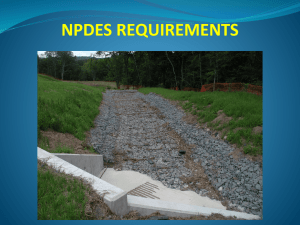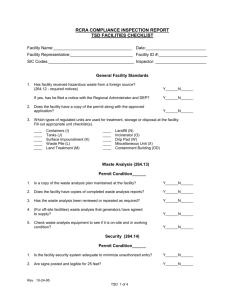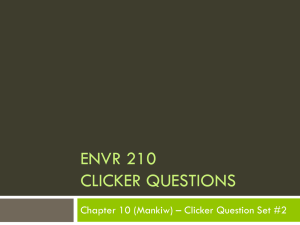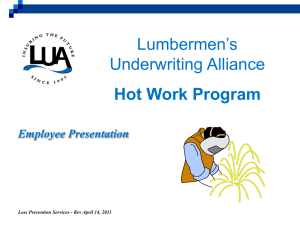UNIVERSITY OF NORTHERN IOWA
advertisement
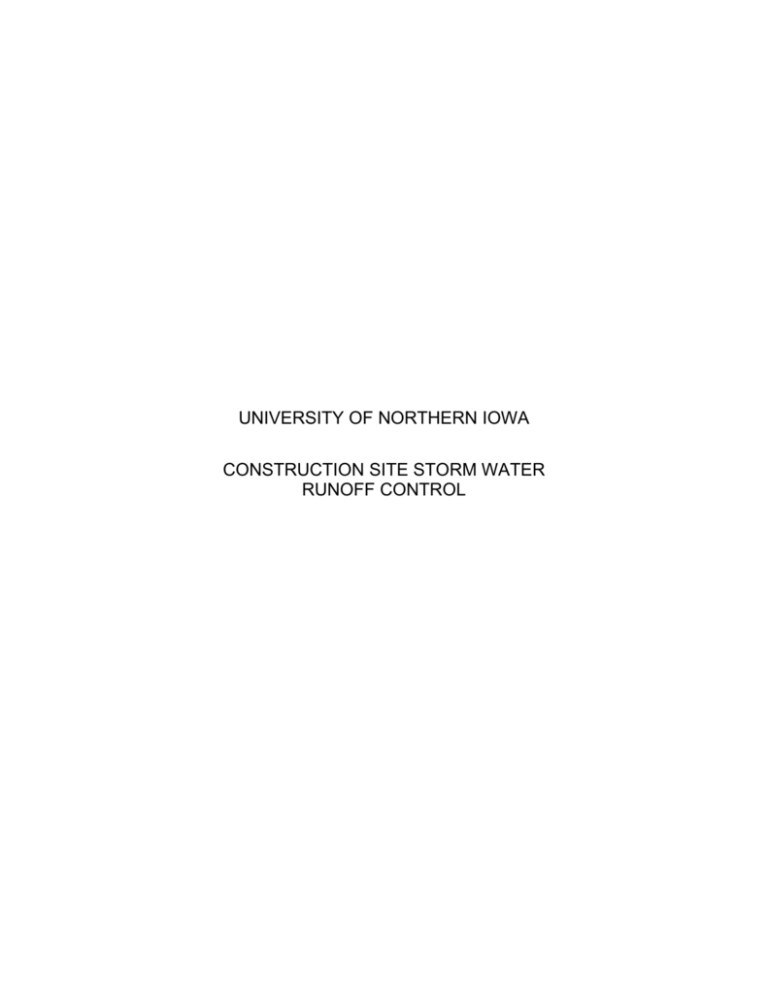
UNIVERSITY OF NORTHERN IOWA CONSTRUCTION SITE STORM WATER RUNOFF CONTROL Construction Site Runoff Control Policy Statement All sites within the University of Northern Iowa and Cedar Falls are under the general requirements of a Type 2 General Permit. Therefore all sites shall follow Best Management Practices for Sediment and Erosion Control and prevention of pollutants from entering the storm water systems. All construction projects regardless of type or size shall follow generally accepted Best Management Practices as outlined in the Iowa Construction Site Erosion Control Manual and the Iowa Department of Transportation Erosion Control Standards. Projects that will disturb one acre or more shall obtain a project specific NPDES permit. All construction contract documents shall reference the requirement for NPDES permits and best management practice for controlling pollutants. UNIVERSITY OF NORTHERN IOWA Standard Operations Procedures for NPDES Construction Permits 2008 1. Definitions 2. Project Design 3. Pollution Prevention Plan Overview General Notes Project Specific Notes 4. Storm Water Discharge / Permit Is a Storm Water Permit Required? Notice of Intent Notice a Discontinuation Prohibition of Non-Storm Water Discharge Reporting Spills Retention of Records Standard Permit Conditions Reference Information Brief History NPDES Permitting Transfer of Coverage Related Legislation to NPDES Permitting Enforcement and Penalties DEFINITIONS Contractor – Independent party hired by UNI to perform the work required by the project. Design Professional – Consultant hired by UNI to design project and sediment and erosion control measures. Design Representative – Member of UNI’s Facilities Planning that coordinates project requirements with the Design Professional. Design Team – The Design Representative, Design Professional and all subconsultants. Discharge – Any addition or release of any pollutant, storm water or other substance into the storm drainage system. Facilities Planning – UNI department responsible for coordinating all construction projects. Hazardous Condition – Any situation involving the actual, imminent or probable spill, leak or release of a hazardous substance onto the land, into the water or into the atmosphere which, because of the quantity, strength or toxicity creates an immediate or potential danger to the public health safety or to the environment. Hazardous Substance – Any substance that presents a danger to the public health or safety. IDNR – Iowa Department of Natural Resources NPDES – National Pollutant Discharge Elimination System OCR – UNI’s Owners Construction Representative assigned to the project. PPP – Pollution Prevention Plan Pollutant – Any type of industrial, municipal or agricultural waste discharged into water including but not limited to soil, solid waste, sewage, garbage, concrete, chemicals. Release – To dump, spill, leak, pour or otherwise introduce into the storm drainage system. Safety Office – UNI’s Environmental Health and Safety Office. Storm Water Discharge Associated With Construction Activity – Refers to a discharge of pollutants into storm water runoff from areas where soil disturbing activities, construction materials or equipment storage or maintenance or other storm water related to the construction process are located. Project Design Schematic Design No NPDES requirements at this stage. Design Development Design Representative will submit a set of review documents to the Physical Plant to review the drawings and comment on any specific requirements for the Pollution Prevention Plan. The Design Professional will determine if the project requires a NPDES Construction Storm Water Permit. If a permit is needed the Design Professional shall notify the OCR for the project. Construction Documents Design Representative will provide a set of Construction Documents to the Physical Plant for review and comment. The OCR shall complete the permit, public notification and fee submittal. Copies of this information shall be provided to the Safety Office. The OCR will receive a letter from IDNR including the permit authorization number. The Design Team will be notified and the letter filed in the project file and published on Centric Project. The OCR will require the Contractor to certify (by signing) the Pollution Prevention Plan as part of the NPDES permit. The OCR will direct the Contractor to maintain a copy of the current PPP and Inspection Report throughout the life of the project. The plan may be modified to reflect changing conditions with approval of the Design Professional. Copies of inspection reports shall be posted on Centric Project monthly by the Contractor. The OCR shall review conditions with Safety Office staff on completion of the site work. At Substantial Completion, the Safety Office will continue the required inspection reports unless final stabilization has already occurred and the Notice of Discontinuation has been filed and accepted. Within 30 days of final stabilization a Notice of Discontinuation shall be filed by the Safety Office. All project documentation shall be maintained on Centric Project. POLLUTION PREVENTION PLAN Overview On all projects that require a project specific permit, a Pollution Prevention Plan will be included as a requirement of the Construction Documents: Pollution Prevention Plan will be posted with the construction documents on Centric Project. Minimum Inspection Report contents Contractor’s certification statement Dates when major grading activities occurred and when stabilized Name of the inspector Title of the inspector Date of inspection Scope of inspection Any actions required based on the inspection When and how the Inspection Report is submitted, maintained Responsibilities for Maintenance of, amendments to and submittal responsibilities for the Pollution Prevention Plan Erosion control measures Inspections and reporting Compliance with IDNR. Site description Total area impacted (define current land cover) Soil types Slope Current land use Run-off coefficients Drainage patterns (including designation of potential wetlands) and drainage outlet Erosion and Sediment Controls Stabilization o Define measures to be taken to control run-off from the site during and following construction Structural Controls o Define measures to be taken to stabilize the site during and following construction Other prevention Measures Pollution Prevention Plan certification statement with signature blocks General Notes The IDNR may notify UNI at any time that the PPP does not meet minimum requirements. After such notification and direction from UNI, the Design Professional shall amend the PPP within 7 days of IDNR notification. The OCR shall submit to the IDNR a written certification that the requested changes have been made. The PPP shall be amended whenever there is a change in design, construction, operation, or maintenance that has a significant effect on storm water discharges. The contractor’s inspector will prepare an “Inspection Report” (see exhibit A) which shall include the following certification statement signed by an authorized representative of the Contractor: “I certify under penalty of law that this document and all attachments were prepared under my direction or supervision in accordance with a system designed to assure that qualified personnel properly gathered and evaluated the information submitted. Based on my inquiry of the person or persons who manage the system, or those persons directly responsible for gathering the information, the information submitted is, to the best of my knowledge and belief, true, accurate, and complete. I am aware that there are significant penalties for submitting false information, including the possibility of fine and imprisonment for knowing violations.” It is the responsibility of the Contractor to take all actions necessary for the installation of control measures for compliance with the general permit. The Contractor is responsible for any fines/penalties imposed by the IDNR related to failure to enforce pollution prevention plan measures. The Contractor is also responsible for fines as outlined in the specifications. The Contractor shall provide personnel to inspect disturbed areas of the construction site and to inspect the site controls. UNI requires an inspection every 7 days and within 24 hours of the end of a rain or snow melt. The Inspection Report shall include dates when major grading activities occurred or ceased in areas and shall include dates when areas were stabilized. At a minimum each report shall include: the name of the inspector, the title of the inspector, date of inspection, scope of inspection, any actions required based on the inspection. Copies of inspection reports shall be submitted to UNI monthly with the Application for Payment and the Pollution Prevention Plan shall be updated to reflect actions taken. Maintenance of all temporary and permanent erosion control measures is the responsibility of the Contractor. Cleaning of silt control devices shall begin when they have lost 50% of their capacity. Project Specific Notes The following is a general outline of information to be developed by the Design Professional for the permit application or PPP. SITE DESCRIPTION 1. This project includes _______________________________________________ ________________________________________________________________ ________________________________________________________________ ________________________________________________________________ (brief description of proposed construction activities and sequence here) 2. The total project area is _______ acres. ________________________________ are the predominant land disturbing activities for the project. The estimated disturbed area for these activities is ______ acres. 3. Existing soils on the site are ________________. (soil description from a source such as the Blackhawk County Soil Survey or other records). The thickness of the topsoil on site will vary, but can be estimated as ________ inches for a reasonable site average. Current soils on site are estimated to have ___________ (high, low, moderate) erosive potential. Current land use is _________________________ ________________________________________________________________ ________________________________________________________________ (describe). Soils on steeper slopes are susceptible to erosion. In general, slopes on the site are _____________. (flat 1-3%, moderate 3-9%, steep 10%+) The construction season (April through September) generally has 3 to 5 inches of rain per month, peaking in June. The last freezing temperatures are typically recorded in April, and the first freezing temperatures are typically recorded in October. Heavy snow melts are likely in March. An estimate of the run-off coefficient of the site after completion of construction activities is _____________________________________________________. 4. See the Pollution Prevention Plan map for drainage patterns and slopes, locations of disturbed areas, location of structural controls and/or stabilization areas, and surface waters (including potential wetlands). 5. The project site generally drains into _________________________________. (describe outlets) See the Pollution Prevention Plan map for storm drainage outlet locations, as well as general drainage patterns. EROSION AND SEDIMENT CONTROLS ______________________________________________________(project name here) A. STABILIZATION 1. 2. Disturbed areas of the construction site that will not be re-disturbed for 21 days or more must initiate stabilization measures by the 14th day after the last disturbance, except as hindered by snow cover. Minimize disturbed areas. Match existing land contours when possible. Minimize impervious surfaces. Protect natural vegetation and trees outside of construction areas and disturb to a minimum inside construction areas. 3. 4. 5. 6. 7. 8. 9. 10. B. The project will use staged construction to minimize the amount of land disturbed at any one time. Y/N Composting or mulching shall be used in conjunction with seeding for erosion control. Y/N Temporary or permanent seeding or sodding will be used ____________ _________________________ (describe) Y/N Jute mesh or mats shall be used on steep slopes in conjunction with seeding. Y/N Buffer strips of existing vegetation will remain adjacent to construction zones. Y/N Geotextile will be used beneath graveled site areas or beneath rip rap. Y/N Stream/ditch bank stabilization such as rip rap or gabions will be used ___________________________________________(describe) Y/N Dust control on the site is required and will consist of ______________ _______________________ (describe). (sprinkling, gravelling, chemical stabilization, etc.) STRUCTURAL CONTROLS 1. Controls shall be placed downstream of disturbed areas as shown on the plan and as required in other areas as determined by UNI or Contractor during construction. See the appropriate construction details on Pollution Prevention Plan. 2. A sediment basin is required for this project if there is more than 10 Acres of disturbed ground in a common drainage area. See the detail on the Pollution Prevention Plan for correct installation of sediment basin. A sediment basin will be used ___________________________________ (describe) Y/N 3. Inlet and outlet protection of culverts and storm sewer intakes is required. Protect inlets/outlets with silt fence, rip-rap, compost socks, straw bales, sediment traps, or other approved methods. (describe) ______________ __________________________________________________________ 4. Subsurface drains will be installed to artificially lower the water table during construction. (describe)_____________________________ Y/N 5. A permanent storm water retention/detention structure is to be constructed. (describe)___________________________________ Y/N 6. A permanent wetlands detention feature is to be constructed. (describe) ____________________________________________________ Y/N OTHER PREVENTION MEASURES 7. Construction entrances adjacent to public/private roads shall be graveled immediately to prevent vehicle tracking. Use geotextiles beneath these graveled areas. The Contractor shall promptly clean up site material tracked onto adjacent streets/property, and replace and refresh gravel as needed. 8. Provide waste receptacles at convenient locations and provide regular collection of wastes, litter including building material wastes and sanitary sewers. 9. Monitor construction vehicle maintenance areas. Washing and fueling operations can generate spills/run-off. 10. Provide designated areas for concrete truck washouts that have controlled outlets. All debris and remaining concrete to be removed from the site on completion of the construction. STORM WATER DISCHARGE PERMIT Does The Project Need a Storm Water Discharge Permit? 1. Sites where the area disturbed will be 1 acre of more require a permit. 2. Projects that are part of a larger plan or project being constructed in stages the total of which will exceed one acre require a permit. 3. Sites with less than one acre of disturbed ground as calculated by the engineer shall be permitted if FP concludes that there is a reasonable chance the Contractor may disturb more than one acre by unforeseen construction events. FP shall immediately notify the engineer in any such case. 4. Areas that will remain paved throughout the construction period or that are otherwise protected from construction activities may be discounted, unless soil or erodible materials are stored on paving. Items not classified as a land disturbing activity: 1. Geotechnical drilling or construction staking on the site. 2. Material storage and/or construction-related vehicular traffic on preexisting paved areas. If FP determines the project requires the acquisition of a permit they will notify Physical Plant; the permit is identified as an Iowa Department of Natural Resources NPDES General Permit No.2 “Storm Water Discharge Associated with Industrial Activity for Construction Activities”. Notice of Intent A completed Notice of Intent must include the following: 1. The completed form 1415 entitled “Notice of Intent for NPDES Coverage Under General Permit”. A PDF of this form can be found at: http://www.iowadnr.com/water/stormwater/forms/5421415.pdf 2. Proof of Public notification from the two newspapers in the area with the highest circulation. A PDF form to use for submitting to the newspapers for publication can be found at: http://www.iowadnr.com/water/stormwater/forms/pub_gen2.pdf 3. Permit fee Mail completed NOI, check payable to IDNR for fee amount, and proof of public notices to Storm Water Coordinator Department of Natural Resources 502 E. 9th Street Des Moines, IA 50319-0034 If you need assistance contact the IDNR at 515-281-7071 and ask for “Storm water general permit assistance.” Or visit the IDNR Water Quality Bureau website @ http://www.iowadnr.com/water/stormwater/index.html When a complete NOI is submitted to the IDNR, the project is assumed to be covered under the General Permit unless otherwise notified by the IDNR. As part of the NOI submittal to the IDNR, proof of public notice of UNI’s intent to be covered under the General Permit and payment of the permit fee must be included. After favorable review, the IDNR will send the applicant (UNI) a letter stating that the NOI was received and will assign it a permit authorization number. This letter will be sent to the person listed under the “contact information” portion of the NOI (Physical Plant). This number should accompany all further correspondence with the IDNR. Prior to the start of construction, the Contractor shall certify (by signing) the Pollution Prevention Plan that has been previously developed by the Design Professional as part of the Storm water discharge permit requirements. A copy of the Pollution Prevention Plan shall be maintained on the job site (if possible) and as part of the project records throughout the life of the project. Notice of Discontinuation The OCR will notify the Safety Office when all site related project activities are complete and the Contractor is ready to vacate the site. At this time the OCR will notify the Safety Office and arrange a meeting to review site conditions and officially turn the site over to the Safety Office. Within 30 days after final stabilization of the site, the Safety Office shall submit a Notice of Discontinuation to the IDNR. For a PDF form see: http://www.iowadnr.com/water/stormwater/forms/2_nod.pdf Physical Plant will make the final determination of when the site has reached the 30 days following final stabilization and submit the Notice of Discontinuation to the IDNR. Safety Office will transmit a copy of the Notice of Discontinuation to the OCR. As a courtesy, the IDNR will send a letter to UNI approximately one month before coverage under the permit expires. This letter will be sent to the person listed under the “contact information” portion of the NOI (Physical Plant). At this time, Physical Plant will notify the OCR and determine if the permit coverage should be extended or prepare to file the notice of discontinuation. Prohibition on Non-Storm Water Discharges All discharges authorized by this permit shall be composed entirely of storm water except for the following allowed non-storm discharges: fire fighting activities, fire hydrant flushing, vehicle washing, potable water source flushing, irrigation drainage, routine external building washing (no detergents), pavement washing (free of detergents, toxic and hazardous materials), air conditioning condensate, natural springs, and foundation/footing drains not contaminated by building processes. RETENTION OF RECORDS Facilities Planning shall retain, on Centric Project, the Pollution Prevention Plan, the Notice of Intent, the Inspection Report and the discontinuation notice and correspondence for at least 3 years after the site is finally stabilized. The Contractor shall provide the OCR a copy of all changes made to the Pollution Prevention Plan during construction and a copy of the Inspection Report for OCR’s records. The OCR will submit these to Physical Plant as part of the project close-out procedures. A copy of the current records mentioned above shall be filed on site during project construction and be made readily available to the IDNR upon request. STANDARD PERMIT CONDITIONS The Contractor is encouraged to view the listing of Standard Permit Conditions that apply to this general permit. The general permit can be viewed on-line at the IDNR website at http://www.iowadnr.com/water/stormwater/forms/2_general.pdf The Contractor will be provided a copy of the general permit upon request. REFERENCE INFORMATION http://www.cicacenter.com/index.cfm http://www.state.ia.us/epd/wastewtr/stormwtr/storwtr.htm Notice of Intent form: http://www.iowadnr.com/water/stormwater/forms/5421415.pdf Public Notice of Storm Water Discharge: http://www.iowadnr.com/water/stormwater/forms/pub_gen2.pdf Notice of Discontinuation: http://www.iowadnr.com/water/stormwater/forms/2_nod.pdf Summary of General Permits: http://www.iowadnr.com/water/stormwater/forms/2_ppp.pdf Exhibit A: Sample NPDES Inspection Report Project Name: ________________________________ Date: _________________ Name of Inspector:_____________________________ Title:__________________ Type of Inspection: Weekly Inspection Storm Inspection (rainfall in last 24 hours _________”.) Area Inspected: _______________________________________________________ Observations: Are any changes necessary to the storm water pollution plan? Yes ___ No ___ If yes, provide details: Have any releases occurred since the last inspection report? Yes ___ No ___ If yes, provide the following information: Date of release: Circumstances leading to the release: Steps taken to prevent reoccurrence of the release: Note: If a hazardous condition occurs, contact the OCR or Physical Plant within six hours of the hazardous condition. If the release occurs after hours, contact Department of Public Safety and they will contact the Physical Plant. CONSTRUCTION SITE INSPECTION PROGRAM All projects on campus are subject to the requirements of our general permit and must adhere to the specification requirements established to minimize sedimentation and erosion. Small non permit projects will be inspected after every rainfall of ½” or more by our Safety Office staff. If problems are noted or suspected, more frequent visits will be conducted as required based on activity at the project site. Projects with job specific permits shall be inspected weekly and after every rainfall by both the Contractor’s superintendant and UNI Safety Office staff. Reports shall be completed and filed at the job site and in the UNI project file. The Contractor’s superintendent shall inspect and maintain the protective measures a minimum of once every 7 days and after every rain. The inspection must include all disturbed areas of the site; areas of material storage, locations where vehicles enter and exit the site, all of the sediment and erosion controls that were installed must be inspected. The inspector must prepare a written report summarizing his inspection. It shall include as a minimum 1. The name of the person making the inspection. 2. The date of the inspection. 3. Identify any damages or deficiencies in the control measures. 4. Identify actions taken to correct the problems found. 5. Identify what actions will be taken to modify procedures. 6. Include the following certification statement signed by an officer of the contracting company. Inspection Report Certification Statement “I certify under penalty of law that this document and all attachments were prepared under my direction or supervision in accordance with a system designed to assure that qualified personnel properly gathered and evaluated the information submitted. Based on my inquiry of the person or persons who manage the system or those persons directly responsible for gathering the information, the information submitted is, to the best of my knowledge and belief, true, accurate and complete. I am aware that there are significant penalties for submitting false information, including the possibility of fine and imprisonment for knowing violations.” Maintenance of required controls and facilities shall be recorded. This can be accomplished on the periodic reports. The contractor shall also keep a log of construction activity on site including: 1. 2. 3. The dates when major grading activities occur. The dates when construction activity ceases in an area and if it is temporary or permanent. The dates when an area is stabilized either temporarily or permanently. Copies of these records shall be provided to the OCR on a monthly basis, with the application for payment and the updated schedule. If the Storm Water Pollution Prevention plan is not working the contractor shall work with the Design Professional to immediately address the defects and make corrections to the plan as needed. The Contractor shall be responsible for complying with all requirements of the plan and regulations. At project closeout the contractor shall furnish a complete set of documents covering inspections, maintenance, construction activities and the Notice of Discontinuation to the OCR. In addition to regular inspections at all projects, the OCR shall visit the project daily and report to the contractor and UNI environmental staff if problems are noted. The OCR shall record the problem in the project file and the contractor and UNI environmental staff shall complete report forms describing the problem and the corrective measures implied to correct the problem. SITE INSPECTION REPORT Project Date Inspection Type of Inspection YES NO Describe Corrections Made 1. Erosion control in place 2. Sediment traps in place 3. Sediment controls at perimeter 4. Sediment control at inlets 5. Stable rock entrances in place 6. Roads clean of mud 7. Exposed slopes protected 8. Stockpiles stabilized 9. Dust control in place 10. Concrete washout area established Changes required _______________________________________ Signed

